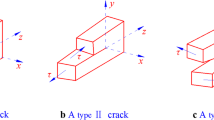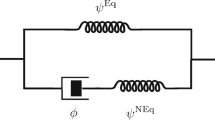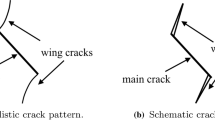Abstract
Mating fracture surfaces developed by slow cracking in salt water and rapid overload fracture were studied by replication and scanning electron microscopy to determine the formation mechanism of the periodic ridges and valleys (“zigzag” fracture) characteristic of surfaces in materials which separate by homogeneous microvoid coalescence. The most significant findings are: 1) The apex of each ridge, which consists of a rim of tear dimples, is sharply defined; while by contrast the bottom of each mating valley is gently rounded, as the mating tear dimples have been severely elongated to form an extensive stretch zone, the back edge of which mates with the peak of the ridge. Thus it appears that this form of fracture is a continuous process in that a moving crack front is maintained, even though the plane of the crack changes orientation with crack length. The crack advances along the first plane inclined to the macroscopic Mode I fracture plane, is then interrupted by a forward stretching step, which is followed by cracking along the second inclined plane. A rationale for this behavior is presented in terms of a simple tension-compression model within a constrained plastic zone. 2) Elongated dimples on each incline are of two types, tear and shear, with the former clearly dominating. This observation implies a strain gradient in the process zone near the crack tip, with the point of maximum strain located at the crack tip. The photomicrographs support a model involving tearing along alternating shear planes.
Similar content being viewed by others
References
G. R. Yoder:Met. Trans., 1972, vol. 3, pp. 1851–59.
C. A. Berg:Inelastic Behavior of Solids, pp. 171 -209, McGraw-Hill, New York, 1970.
F. L. Carr, J. Nunes, and F. R. Larson:Amer. Soc. Test. Mater., Spec. Tech. Publ. 407, p. 203, ASTM, Philadelphia, 1968.
J. Nunes, F. L. Carr, and F. R. Larson:Techniques for Metals Research, R. F. Bunshah, ed., vol. 2, part 1, p. 379, John Wiley and Sons, Inc., New York, 1968.
C. D. Beachem:Trans. ASM, 1963, vol. 56, pp. 318–26.
F. A. McClintock and G. R. Irwin:Amer. Soc. Test. Mater., Spec. Tech. Publ. 381, pp. 84–113, ASTM, Philadelphia, 1965.
P. C. Paris and G. C. Sih:Amer. Soc. Test. Mater., Spec. Tech. Publ. 381, pp. 30–83, ASTM, Philadelphia, 1965.
C. D. Beachem and D. A. Meyn:Amer. Soc. Test. Mater., Spec. Tech. Publ. 436, p. 59, ASTM, Philadelphia, 1968.
C. D. Beachem:Trans. ASM, 1967, vol. 60, p. 329.
D. A. Broek:Eng. Fract. Meek, 1969, vol. 1, no. 4, pp. 691–95.
U.C. D. Beachem:Met. Trans., 1972, vol. 3, pp. 437–51.
P. P. Puzak, K. B. Lloyd, R. W. Huber, R. J. Goode, E. A. Lange, C. N. Freed, T. W. Crooker, R. W. Judy, Jr., and D. G. Howe: NRL Report 6513, August 1966.
Author information
Authors and Affiliations
Rights and permissions
About this article
Cite this article
Beachem, C.D., Yoder, G.R. Elastic-plastic fracture by homogeneous microvoid coalescence tearing along alternating shear planes. Metall Trans 4, 1145–1153 (1973). https://doi.org/10.1007/BF02645619
Received:
Issue Date:
DOI: https://doi.org/10.1007/BF02645619




